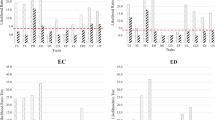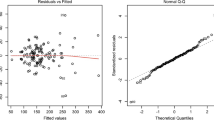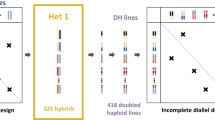Abstract
Diallel mating designs have proved informative in determining the inheritance of quantitative traits of interest to plant breeders. Apart from the well-established analyses of a complete diallel, the two-way factorial data structure of this design lends itself to analysis by the additive-main-effects-and-multiplicative-interaction (AMMI) model. This research article describes the joint application of the AMMI model and Griffing’s method 1, model I, to gain insight into the breeding value of inbred lines in a self-pollinated crop such as disomic, hexaploid bread wheat. Data from a multi-environment trial of a complete diallel cross between eight lines adapted to the East African highlands were analyzed to provide an example of this joint analysis. This combined approach identified not only the direction of a cross, i.e. which parent should be male or female, but also which crosses produce offspring showing F1 heterosis.
Similar content being viewed by others
Author information
Authors and Affiliations
Additional information
Received: 10 June 2000 / Accepted: 31 July 2000
Rights and permissions
About this article
Cite this article
Ortiz, R., Madsen, S., Wagoire, W. et al. Additive main effect and multiplicative interaction model for a diallel-cross analysis. Theor Appl Genet 102, 1103–1106 (2001). https://doi.org/10.1007/s001220000452
Issue Date:
DOI: https://doi.org/10.1007/s001220000452




